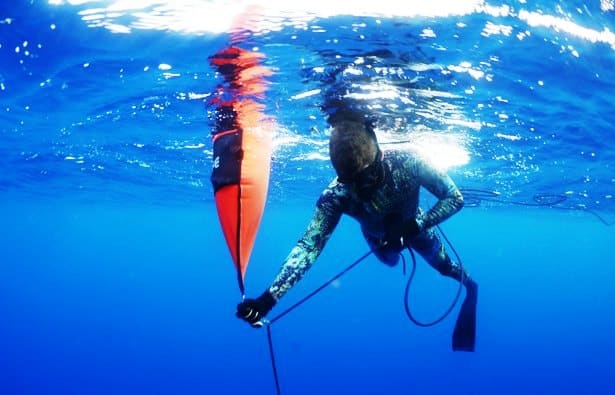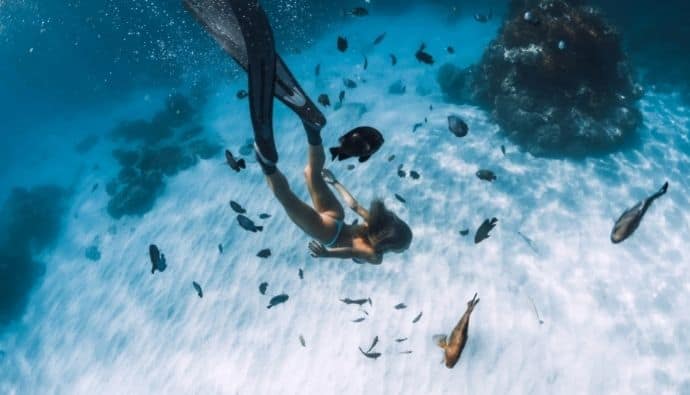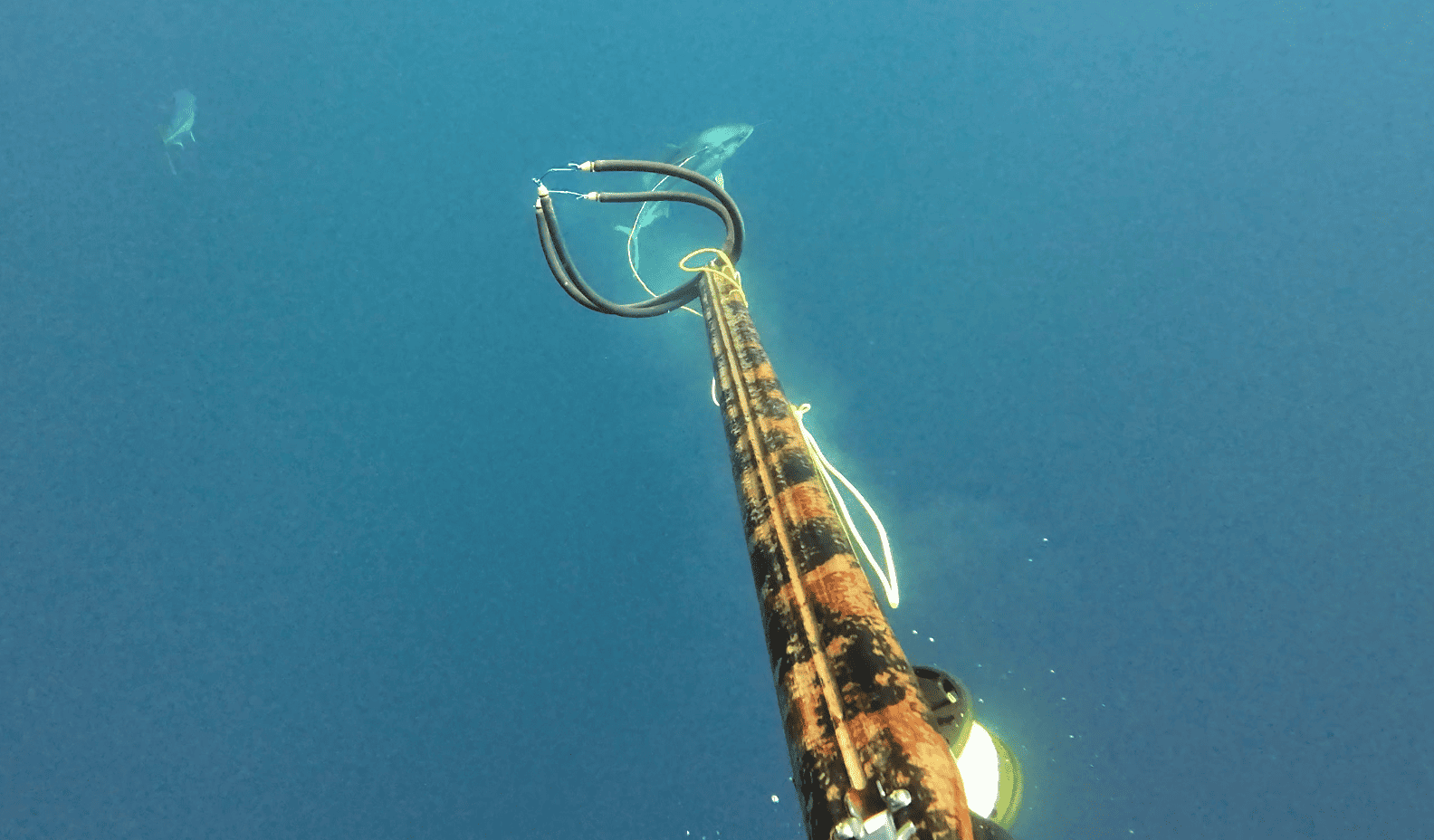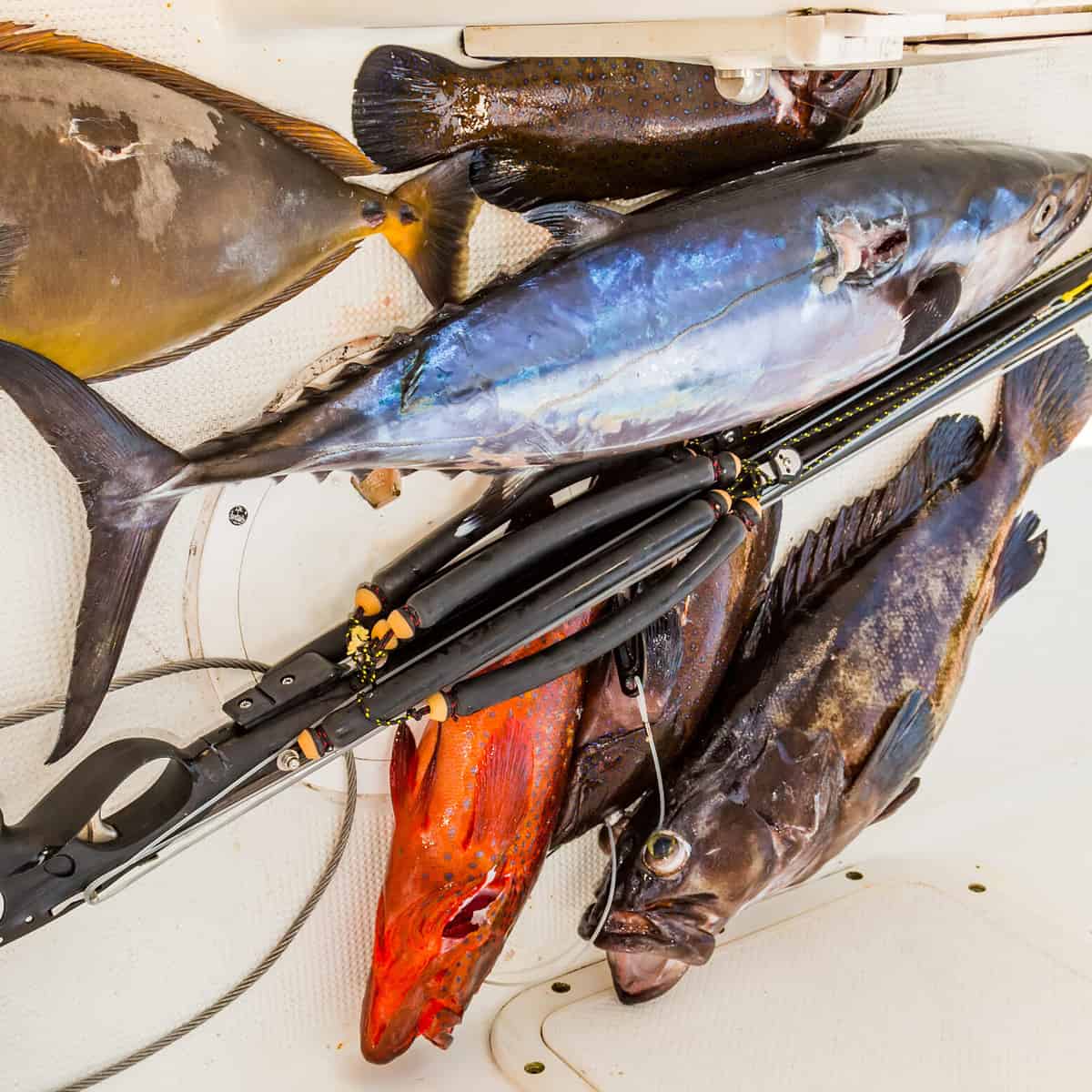It is essential to know and understand how fish behave and what the size limits are of any particular fish you are hunting, especially while spearfishing California waters.

If you understand where to look and what their habits are, you have a better chance of finding them. Once you start thinking like a fish, you’ll automatically start seeing more fish and significantly improve your chances of becoming a better spearfisherman or spearfisher woman (we’ll stick with spearo for article simplicity).
Listen to the Cast & Spear Podcast
Subscribe to the Cast & Spear Podcast on iTunes
Also, the more relaxed you are, you will see more fish. These are all vital first steps to becoming a successful spearo.
Spearfishing California: List of Southern California Fishes
It is essential to have some knowledge of the different kinds of fish, their size limits, and the daily limits before undertaking any spearfishing (or fishing). It is the responsibility of the spearo to know these rules. If Fish and Wildlife catch you with under-sized or over-limit fish, you could be facing a hefty fine, and you could even risk having your gear and your fish confiscated.
Below is a list of fish that a beginner spearo might target in the first or second year of spearfishing. Please keep in mind that anything having to do with rules or laws in this list are pertaining only to the Fish and Wildlife Rules (regulations) of California.
The daily limit for the state of California for the total amount of fish caught or speared is twenty-fish per day is 20 fish and no more than ten species of each.
Rubberlip Perch

Rubberlip Perch Facts:
- Names: Rubberlips, bigmouth
- Scientific Name: Rhacochilus toxotes
- Identifying Characteristics: Thick white or pale pink lips.
- Locations for How to Catch: Found from Mendocino County (Northern California) to central Baja California. Abundant near kelp beds, rocky reefs, pilings, oil platforms, and sometimes in quiet blackwaters (rarely in the surf).
- Size: 4 pounds
- Limit: No limit
Rubberlip Perch can grow to four pounds. Find them from Mendocino County to Southern Baja, California. They are the most massive surf perches off the California Coast. They prefer rocky areas and kelp beds. These fish usually are in schools, so you might be able to get more than one fish out of each school.
Pile Perch
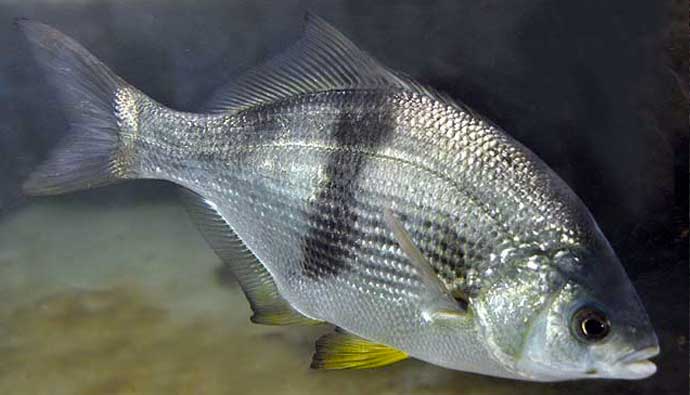
Pile Perch Facts:
- Names: Pile Perch, Piler
- Scientific Name: Damalichthys vacca
- Identifying Characteristics: Usually grey, occasionally brown or dusky, usually with a dark mid-body bar on the sides. They have a deeply forked caudal fin, and the soft rays of the second dorsal fin are long.
- Locations for How to Catch: Occur from southeastern Alaska to north-central Baja California. They are taken from the shallows and down 690 feet depth. They tend to move into shallow waters during the winter and Spring.
- Size: 3 pounds
Pile Perch can grow up to three pounds. They can be found off rocky shores and around kelp beds. These fish usually are in schools, so you might be able to get more than one fish out of each school.
California Corbina
California Corbina Facts:
- Names: Berrugata
- Scientific Name: Menticirrhus undulatus
- Identifying Characteristics: Long, thin croakers with a short chin barbel. Corbina is usually gray or bluish (occasionally brown) on the back and white below.
- Locations for How to Catch: Corbina goes from Pt. Conception to the Gulf of California. Almost always over sandy bottoms, usually, there is great wave action. They are found in water so shallow their backs show and down to 150 feet. Often found in groups of 2-5 fish.
- Size: Seen up to 32.6 inches and up to 8 pounds.
California Corbina can grow up the eight pounds. Small groups of these species travel along the bottom of the sandy beaches in shallow bays. When there is not much surf, and the sandy beaches are definite, this is the best time to hunt this fish.
Black Croaker
Black Croaker Facts:
- Names: China Croaker, Chinese Croaker
- Scientific Name: Cheilotrema saturnum
- Identifying Characteristics: Perch-shaped croakers with black colors of dusky, purplish, bluish, brownish, or coppery hues and silvery bellies. The rear part of the gill cover is black, and there is a pale bar at the midbody.
- Locations for How to Catch: Live from Pt. Conception to northern Baja, California. They prefer rocky reefs and kelp beds and are often found in crevices and caves. They are abundant at 10-50 feet and as deep as 150 feet. Young ones swim in schools, and adults are either in schools are alone.
- Size: 2 pounds
Black Croaker grows up to two pounds. Find them along the open coast and sloughs south of Point Conception in California. Adults are often found in rocky areas, as well as in caves and dark crevices. However, they may also be in sandy areas.
Spotfin Croaker
Spotfin Croaker Facts:
- Names: Spotfin Croaker
- Scientific Name: Roncador stearnsi
- Identifying Characteristics: Spotfins have an apparent black spot at the base of their pectoral fins. They are bluish-gray or gray on the backs, brassy on the flanks, and white on the bellies. Males may be completely brassy or golden during the breeding season, while females develop blackish streaks on their bellies.
- Locations for How to Catch: Found from Pt. Conception to southern Baja California, most commonly from about Los Angeles Harbor southward. The largest catches are in the shallow water in the late summer. No one knows where the population is the other times.
- Size: 14 pounds
Spotfin Croaker grows up to fourteen pounds. They are found most commonly south of the Los Angeles Harbor. They live along beaches and in bays, over bottoms, varying from coarse sand to heavy mud. The depths vary from four feet to fifty feet.
Yellowfin Croaker
- Names: Yellowfin Croaker
- Scientific Name: Umbrina roncador
- Identifying Characteristics: Yellowfin Croakers have an elliptical shape, and their backs have an arched contour. Their color is a shiny blue-gray with a transition to silvery-white on the belly. The fins are yellow except for the dorsal fins, which are darker.
- Locations for How to Catch: Find them along beaches, harbors, channels, and bays from Point Conception, California, down to the Gulf of Mexico. They tend to be plentiful during the summer along the coast but will move to deeper water during winter.
- Size: Largest ever was 18 inches and 4.5 pounds.
For a more detailed guide, check out our How to Catch Yellowfin Croaker Fish Guide.
California Halibut
California Halibut Facts:
- Names: Bastard Halibut, Monterey Halibut, Flyswater, Barndoors, Chicken Halibut, Southern Halibut, flatties.
- Scientific Name: Paralichthys californicus
- Identifying Characteristics: The best way to determine this flatfish is if you stick your finger in its mouth and it starts to bleed…they have sharp teeth, were other flatfish don’t. Usually brown or blackish with various blotches on the eyed side and white underbelly.
- Locations for How to Catch: They’re found off the Quillayute River, Washington, to southern Baja California, most commonly from about Bodega Bay southward. They are located on soft bottoms but like to be near structures. Find them near rocks, artificial reefs, kelp holdfasts, etc. Even slight irregularities in the bottom will be enough to aggregate them. Also, look for them near sand dollar beds. They live between shore and 600 feet, but most commonly between 5-180 feet.
For more information on How to Catch California Halibut.
Sargo
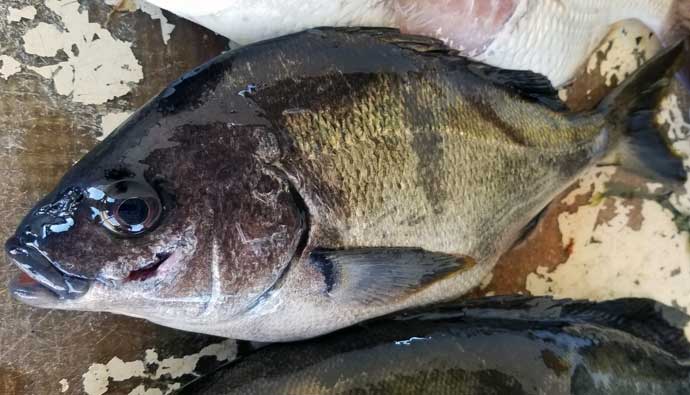
Sargo Facts:
- Names: Sargo
- Scientific Name: Anisotremus davidsoni
- Identifying Characteristics: Sargo is a deep-bodied, perch-shaped fish. Adults almost always have a dark vertical bar on their sides near the midbody. They are usually silver or golden, brassy, or even albino colorings. These are easily confused with Perch.
- Locations for How to Catch: Sargos live from Santa Cruz to southern Baja, California. These are rare north of Santa Barbara. They are schooling fish and are found from the shallows to 198 feet, but mainly in 40 or fewer feet of water. Find them in rocky areas, in sandy areas, and near structures.
- Size: 4 pounds. The largest found has been 19.7 inches.
Sargo grows up to four pounds. They’re found from Santa Cruz to the Southern California border. They are in bays and close to shore. The Sargo’s preferred habitat includes rocky areas and sometimes near sand and submerged structures. They tend to be schooling fish.
For more information on How to Catch Sargo.
Kelp Bass (Calico Bass)

Kelp Bass Facts:
- Names: Bull Bass (big ones), Calico Bass, Cabrilla (Mexico)
- Scientific Name: Paralabrax clathratus
- Identifying Characteristics: These fish have unique markings and are usually brown, gray-brown, or olive on backs and sides, alternating with pale blotches (where the name calico comes from). Their colors are more vibrant the younger the fish is. The third dorsal fin should be the same size as the fourth and fifth dorsals.
- Locations for How to Catch: Kelp bass go from the mouth of the Columbia River to southern Baja, California. Kelp bass love to live around a structure, kelp, rocks, sewer pipes, oil platforms, it doesn’t matter…Guess they don’t need much kelp to be happy. They tend to live solo and can be found as deep as 200 feet but are usually around 10-70 feet deep.
For more information on How to Catch Kelp Bass.
Barred Sand Bass
Barred Sand Bass Facts:
- Names: Sand Bass, Cabrilla (Mexico)
- Scientific Name: Paralabrax nebulifer
- Identifying Characteristics: Barred Sand Bass are greenish to gray with dusky bars on the sides. The smaller they are, the more vibrant in color. Most have freckles on their snouts. Don’t get confused with a calico.
- Locations for How to Catch: Barred Sand Bass go from Santa Cruz to southern Baja, California. This bass loves the sand-rock interface, and you’ll rarely see it over high relief, and they are a significant species on artificial reefs. They are found from the shallows to as deep as 600 feet but mainly stick to around 10-120 feet deep.
- Size: 11 pounds. Barred Sand Bass can reach 25.5 inches and live up to 24 years old.
California Sheephead
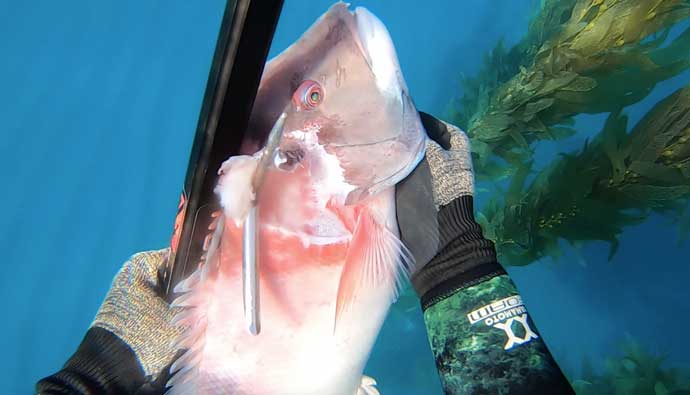
Sheephead Facts:
- Names: California Sheephead, Sheep’s Head, Sheepie, Billygoat, Redfish, Humpy, Vieja (Mexico)
- Scientific Name: Semicossyphus pulcher
- Identifying Characteristics: Color and body shape give these fish away. Young Sheephead looks entirely different than the picture above; they are gold or salmon in color with at least one white stripe along the side and two black spots on the dorsal fin, one on the anal fin, and one on the caudal peduncle. Female Sheephead is pink all over with a white chin. Males look like the picture above.
- Locations for How to Catch: Sheephead are found from Monterey Bay to Isla Guadalupe and into the Gulf of California over reef and kelp. These fish are common on reefs, either alone or in a small group. You can find them in the shallows and as deep as 281 feet, with many around 10 feet deep.
- Size: 40 pounds. Sheephead reaches three feet in length, and males can live to 53 years old, while females live to 30. These are slow-growing fish, so be mindful when you take one.

An interesting side note about the Sheephead is that they start female, and when the big male is taken off the reef by spearo, fishers, or old age, the next biggest female turns into a male. It is also worth noting that a 25-pound Sheephead is approximately 55 years old.
For more information on How to Catch California Sheephead.
Opaleye

Opaleye Facts:
- Names: Button Bass, Opaleye Perch
- Scientific Name: Girella nigricans
- Identifying Characteristics: Opaleye is oval, perch-shaped fish with gray-green or olive-green bodies and blue eyes. Opalyes have between 1 to 3 white or yellowish spots on their backs. You’ll find more spots on the Opaleye found in Baja California, than in Southern California.
- Locations for How to Catch: Opaleye is found from Otter Rock, Oregon, to southern Baja, California. They have been seen as deep as 100 feet but prefer to stay around 5-65 feet depths. Adults tend to swim to midwater and up to the kelp canopy. Tidepool opaleye tends to return to their favorite tide pools at each low tide.
- Size: 6-8 pounds. Opaleye reaches 26 inches.
Opaleye can grow up to six to eight pounds. Located from San Francisco Bay to Southern California. They reside near rocky shorelines and kelp beds, and shallow waters.
For more information on How to Catch Opaleyes.
Lingcod
Lingcod Facts:
- Names: Cultus Cod, Cultus, Blue Cod, Ling, Greenlinger, Slinky Linky, Kin Mutsu (Japanese), Lincod or Bacalao (Mexico)
- Scientific Name: Ophiodon elongatus
- Identifying Characteristics: Lingcod is elongated fish and has a mouth full of canine teeth. They come in many colors ranging from black or brown to blue and green. They often have orange or yellow spots.
- Locations for How to Catch: Lincod is found from the Shumagin Islands (western Gulf of Alaska) all the way south to Ensenada, northern Baja California, and even into the Bering Sea. These fish like colder water, so if you’re in Southern Calfornia, you’ll tend to find them near the Channel Islands. Lingcod have been seen as deep as 1,620 feet deep but reside in less than 100 feet of water. These are bottom-dwelling fish but have been known to rise 20-30 feet to attack hooked rockfish from boat fishers.
- Size: 54 pounds. Lingcod can reach 5 feet and can live up to 20 years old.
They can be found in shallow water when they are spawning. They prefer colder water.
For more information on How to Catch Lingcod.
Cabezon
Cabezon Facts:
- Names: Marbled Sculpin
- Scientific Name: Scorpaenichthys marmoratus
- Identifying Characteristics: Cabezon is large, scaleless, brown, red, or green sculpins covered with darker mottling. They have a flap of skin over their snouts and long, branched flaps over each eye. Most males are reddish, and most females are greenish.
- Locations for How to Catch: Cabezon is found from Sitka, Alaska, southward to central Baja California. They are hard-bottom dwellers and over natural and artificial reefs, oil platforms, and wrecks. The deepest found is 362 feet, but usually around 90 feet deep. They tend to live on the same reef for long periods before moving.
- Size: 25 pounds. Cabezon reaches 30 inches and can live for more than 13 years.
They can be found anywhere along the California Coast, where there are rugged rocks and kelp beds. This popular fish is found in Central and Northern California (they prefer colder water).
For more information on How to Catch Cabezon.
Halfmoon (Catalina Blue Perch)
Halfmoon Facts:
- Names: Catalina Perch, Catalina Blue Perch
- Scientific Name: Medialuna califoniensis
- Identifying Characteristics: These are perch-shaped fish with slate-blue or blue backs, silvery bellies, and half-moon-shaped curved tails.
- Locations for How to Catch: Abundant from Pt. Conception south, half-moons live from Vancouver Island to the Gulf of California. While schooling, they prefer high relief areas such as rocky reefs, kelp beds, oil platforms, and drifting kelp mats. They are found as deep as 130 feet but are mainly between 10-65 feet.
- Size: 5 pounds. Halfmoons can reach 19 inches.
They can grow up to five pounds. They are primarily Southern California fish. They are particularly common around the Channel Islands and Catalina Island over shallow rocky areas near kelp beds. However, they’re in waters from 4 to 65 feet. They are also relatively easy fish to spear.
For more information on How to Catch Halfmoon Fish.
White Seabass (WSB)
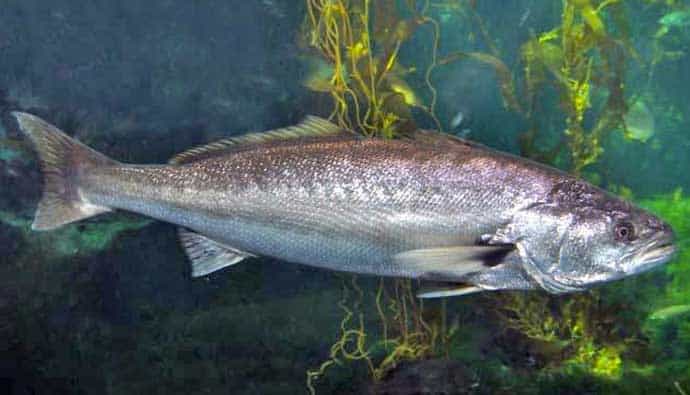
White Seabass Facts:
- Names: Seatrout (small ones), Weakfish, King Croaker, Curvina (Mexico), White Sea Bass
- Scientific Name: Atractoscion nobilis
- Identifying Characteristics: Baby white sea bass is a few inches long and are brown, golden, or silver. Juveniles grow to about 24 inches and are silvery-gray to silvery-dusky with dark bars on their sides. Adults are gray0blue, bronze or almost yellow. Youths mistakenly called white croakers, but remember that white croakers don’t have bars on their sides and do have a tiny barbel on their chins.
- Locations for How to Catch: White seabass are taken from Juneau, Alaska down to southern Baja California, and into the northern Gulf of California. They live in different areas during their growth cycle. Adults found near reefs or kelp beds.
- Size: 93 pounds. White seabass can grow as tall as a human and can live at least 20 years.
They are found state-wide off the California Coast. However, they are seldom seen north of the San Francisco Bay.
White sea bass usually travels in schools over rocky bottoms and through kelp beds. This is a fish that is more appropriate for an advanced spearo to go after.
For a more detailed guide, check out our How to Catch White Sea Bass Guide.
Ocean Whitefish
Ocean Whitefish Facts:
- Names: Blanquillo Pez Blanco (Mexico)
- Scientific Name: Caulolatilus princeps
- Identifying Characteristics: This is an elongated fish with long dorsal and anal fins, and they have a tiny mouth. Ocean whitefish are brown or dan on their backs and white bellow, with fins that are striped with light yellow and blue.
- Locations for How to Catch: Ocean Whitefish have been taken from Vancouver Island, British Columbia to Peru, and are most common south of Pt. Conception. They are found in aggregations and live near the bottom of the ocean or just above it to about 15 feet. They prefer to be over rocks, kelp, and other high relief. They tend to be around 90-200 feet, depending on their size.
- Size: Ocean whitefish grow up to 40 inches and can live at least 13 years.
Ocean Whitefish grow up to 40 inches. They have been caught from Fort Bragg to the Southern California Coast. However, they are rarely seen north of Point Conception. They prefer rocky bottoms and a kelp forest habitat in shallow areas.
Loosely aggregated schools of adults are often found in depths of 10 to 65 feet. The adults swim a few feet above the bottom, dropping down occasionally to the substrate to search for food. They are more abundant around offshore islands and banks than along the mainland coast.
Pacific Barracuda
Pacific Barracuda Facts:
- Names: Barries, Snakes, California Barracuda, Scoot, Scooter
- Scientific Name: Sphyraena argentea
- Identifying Characteristics: Pacific Barracuda are slender fish, long, skinny, and have bluish or brownish backs, silvery sides, and a mouth full of pointed teeth. Males have a tannish, or grayish anal fin, and females have black anal fins.
- Locations for How to Catch: Pacific Barracuda live from Kodiak Island to southern Baja California. They are schooling, more-or-less pelagic fish. Adults are found near reefs or kelp, almost always close to the coast while they are usually close to the surface but can get grabbed as deep as 120 feet.
- Size: 18 pounds. Pacific Barracuda are fast-growing fish and have been taken at 48 inches. They live to at least 11 years of age.
They are usually found south of Point Conception. However, they may range much further north, especially during warm water events such as El Nino. It prefers the upper water layers, from the surface to the depths of 60 feet.
Pacific Bonito
Pacific Bonito Facts:
- Names: Boneheads, Bonies, California Bonito, Skipjack, Laguna Tuna, Magneto, Striped Tuna, Ocean Bonito
- Scientific Name: Sarda chiliensis
- Identifying Characteristics: Bonito are tuna-shaped fish and have dark, slanting stripes on their greenish-blue backs.
- Locations for How to Catch: Bonito are found between Alaska and southern Baja California, while in the south Pacific they range between Peru and Chile. They are found in large schools near the surface and anywhere from just behind the surf to miles out. They are most abundant within 15 miles of the coast.
- Size: Bonito have been known to get to 40 inches, but anything over 36 inches are rare. They are fast-growing and don’t live past six years old.
Pacific Bonito can grow to 25 pounds. They range throughout California state waters, but they are most prevalent south of Point Conception. Sometimes, they arrive off California when the ocean warms in the Spring. However, they may never show up if the conditions dictate colder than average water temperatures.
This is an excellent eating fish. Make sure you bleed it after it’s caught and keep it cool.
For more information on How to Catch Bonito.
Yellowtail
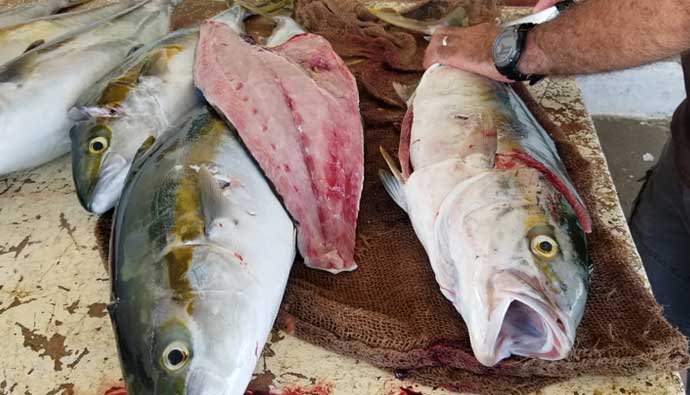
Yellowtail Facts:
- Names: Jurel (Mexico)
- Scientific Name: Seriola lalndi
- Identifying Characteristics: Yellowtail is torpedo-shaped silvery fish, with a yellow to dusky stripe along their sides. They have a dark bar extending through each eye.
- Locations for How to Catch: Yellowtail is found from British Columbia to Chile and worldwide in temperate and subtropical seas. They are common off the coast of Santa Barbara and southward. These jacks usually school but have been seen alone or in small groups, particularly under drifting kelp mats. They like to live near structures such as kelp, rocky reefs, or oil platforms. In open water, they want kelp mats and various other flotsam. They tend to hang between 10 and 20 feet off the surface and have been caught as deep as 120 feet. They are migratory game fish and follow the warm water.
- Size: 87 pounds. Yellowtails grow up to five feet long and up to 12 years of age.
Yellowtail can grow up to 87 pounds. They are found state-wide off of California, but most game fish are taken south of Point Conception.
They can be seen from the surface to at least 200 feet. Prime Yellowtail areas are La Jolla kelp beds, Oceanside and Dana Point, the Horseshoe Kelp, Palos Verdes Peninsula, Catalina Island, and the Channel Islands. This is a game fish that is more appropriate for an advanced spearo to go after.
This is a perfect fish to spear to go after a pole spears record if you have a chance!
For more information on How to Catch Yellowtail.
Bluefin Tuna
Bluefin tuna is in a class of its own. When they roll through our waters, it’s a big deal, and guys chase them with monster tuna spearguns, multiple high-pressure floats, tuna bungees and floatlines, and lots of time on the water.
We’ll share how to tackle those fish in another article.
Spearguns, Floatlines, and Reels for Spearing Fish
Which Spearguns to Use for Spearfishing California Waters
Now that we have covered most of the game fish, you might be considering spearing or catching (as a beginner). We are now going to cover what kinds of spearguns or pole spears are best for spearing certain game fish.
If you want to learn more about spearguns, check out our in-depth guide.
A diver generally prefers to use a speargun with a reel when they are diving from the beach. The reason for this is that a floatline can get tangled in the rocks and kelp. Also, if you swim out with it, then you have to untangle it before you start to hunt.
One thing that I like about a floatline is that if you drop your gun, the floatline will be on the surface so that you can relocate your gun. If, on the other hand, you have a reel on your speargun and you drop it, it will sink to the bottom, and you may never find it (unless the gun floats).
If you decide to go with a floatline, they come to 50-foot, 75-foot, and 100-foot lengths. For a beginner, a 50-foot length will suffice.
Targeting Smaller Fish
If you are starting, you are probably going to be targeting fish less than 15 pounds. Therefore, certain equipment like the size of spearguns is more suited for these sized fish. Anywhere from 60 centimeters to 90 centimeters would accomplish you catch these smaller fish.
If you want to target fish that are 20 pounds or larger, then you can move up to guns from 100 centimeters to 130 centimeters. The reason for the larger spearguns is that they will shoot further and have more penetration at a further distance. This will make things a lot less difficult for you to spear.
When you are hunting bigger fish, I would recommend a reel with at least 200 feet of line with a 200-pound test line (minimum), and a very high visible line (white or yellow). If you are going to use a floatline, I would recommend a 100-foot floatline. If you are in the deep blue water, I would recommend a 2-3 Atmosphere Float.
I recommend that when beginners purchase their first speargun that, they order the guns with the 9/16″ bands. This is because the 5/8″ are harder to load, and most beginners do not have the upper body strength required to load the 5/8″ bands yet.
Which Pole Spears to Use While Spearfishing California Waters
Fishing spears, more commonly known as pole spears, are an ancient method of catching fish.
If you want to learn more about fishing spears, check out our in-depth guide on pole spears.
If a speargun is out of your price range, you can start off with one of the quality pole spears out there. You can start off with the best beginner pole spear. You can get it with a three-pronged Paralyzer Tip or a three-pronged Barbed Paralyzer.
Crist pole spears are also high-quality aluminum fishing spears that can take down any size fish.
If you plan on doing any traveling, the Sea Stinger travel pole spear that breaks down for maximum travel convenience, comes with a single barbed tip and a sharp paralyzer tip for any diving occasion.
Speargun vs. Pole Spear: Which is Better?
Before you start spearfishing, you need to decide whether you are going to use a speargun or a pole spear. A speargun is going to cost you a little more money; however, your first dive will probably be enjoyable. With most spearguns that are advisable for a beginner to start with, you will have a six-to-fourteen-foot shooting distance with which to hit your target.
If you decide to start with a pole spear, then your learning curve is going to be greater. With most pole spears, you will have to get within less than four feet of your target. However, some people enjoy this challenge.
This topic is vast, and there are many things to consider. If you want to learn more about the two methods, check out our in-depth guides below:
This post was inspired by the great work of Dr. Milton Love out of the Love Lab at UC Santa Barbara.
Check out his amazing book: Probably More Than You Want To Know About The Fishes of the Pacific Coast.
If you decide you’d like to visit Santa Barbara to try some spearfishing, be sure to look for some budget accommodation in Santa Barbara so you can make the most of your trip.
Disclaimer: Always check local regulations for updates.
Helpful Links for Fish Identification
- California Ocean Recreational Fishing Regulations (Fish and Game)
- California Fishing Passport – Ocean
- Safe eating guidelines
- Selected Nearshore Fishes of California

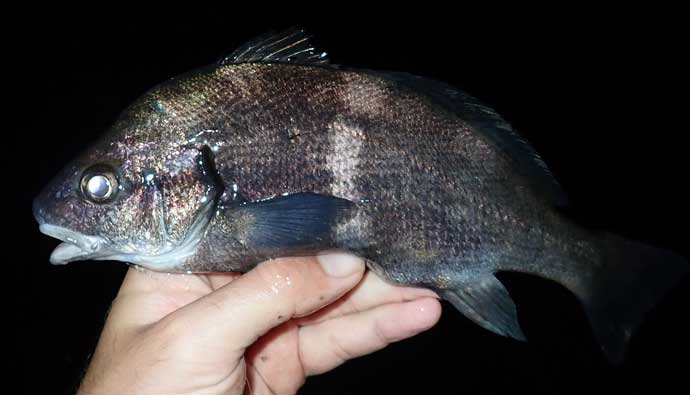
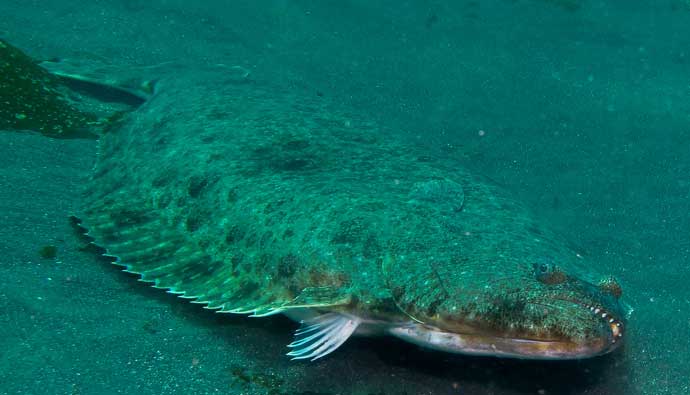
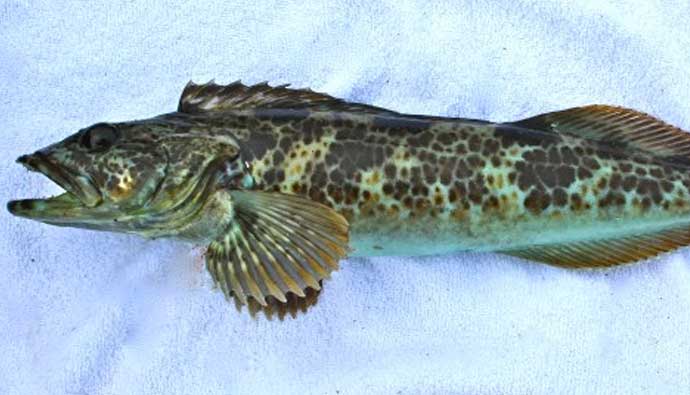

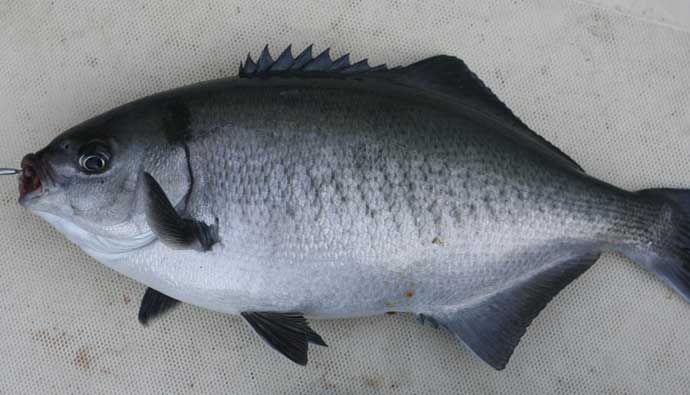
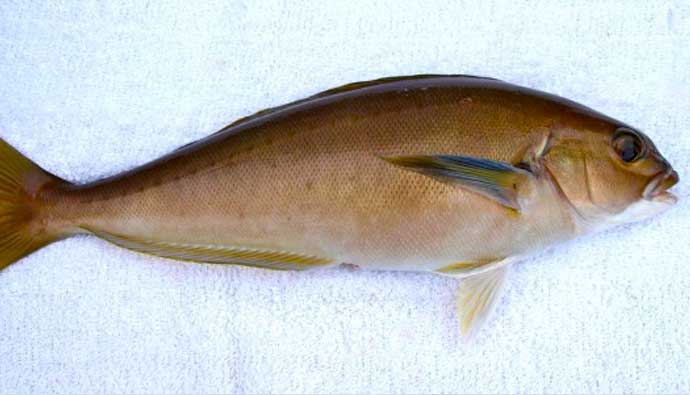
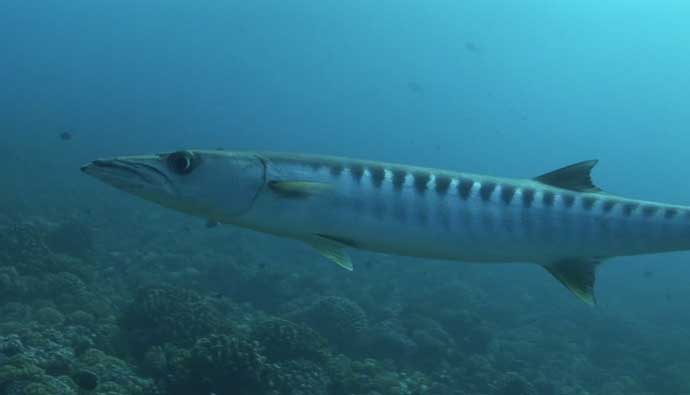
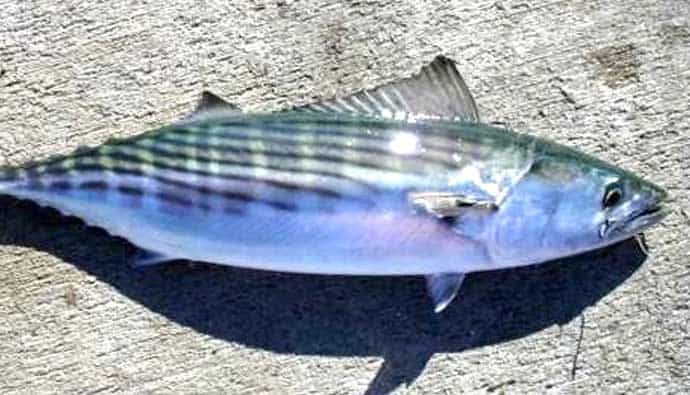



 Facebook
Facebook YouTube
YouTube





